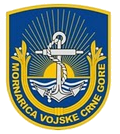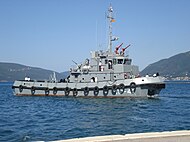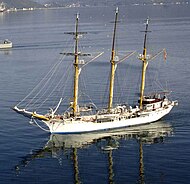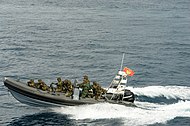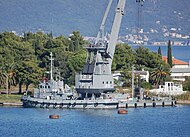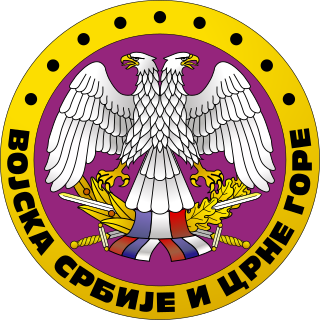
The Armed Forces of Serbia and Montenegro included ground forces with internal and border troops, naval forces, air and air defense forces, and civil defense. Preceding the VSCG was the Yugoslav Army from the remnants of the Yugoslav People's Army (JNA), the military of SFR Yugoslavia. The state, then named Federal Republic of Yugoslavia, participated in the Yugoslav Wars with limited direct intervention of its own armed forces. Following the end of the Wars and the constitutional reforms of 2003 by which the state was renamed "Serbia and Montenegro", the military accordingly changed its name. The military was heavily involved in combating Albanian separatists during the Kosovo War and Preševo Valley conflict, and also engaged NATO airplanes during the 1999 NATO bombing of Yugoslavia.

The Croatian Navy is a branch of the Croatian Armed Forces. It was formed in 1991 from what Croatian forces managed to capture from the Yugoslav Navy during the breakup of Yugoslavia and Croatian War of Independence. In addition to mobile coastal missile launchers, today it operates 30 vessels, divided into the Navy Flotilla for traditional naval duties, and the Croatian Coast Guard. Five missile boats form the Croatian fleet's main offensive capability.

The Yugoslav Navy, was the navy of Yugoslavia from 1945 to 1992. It was essentially a coastal defense force with the mission of preventing enemy landings along Yugoslavia's rugged 4,000-kilometer shoreline or coastal islands, and contesting an enemy blockade or control of the strategic Strait of Otranto.

The Armed Forces of Montenegro are the military forces of Montenegro. The Armed Forces consists of an army, navy and air force.
Montenegro is one of the fastest-growing tourist destinations. In 2007, over a million tourists visited Montenegro, making some 7.3 million overnight stays. This accounted for some 480 million euros in tourism revenue in 2007. In 2015, tourism realised over 1.7 million arrivals, with a further increase in 2016. In the same year, the coastal town of Kotor was named the best city to visit by Lonely Planet, whereas the country itself is continuously included in touristic top lists. With a total of 1.8 million visitors in 2016, the nation became the 36th most popular country to travel to in Europe. Montenegro was further visited by over 2 million tourists in 2017. The Government aims to attract greenfield investments, which should make best use of undeveloped parts of the coast, such as Jaz Beach, Velika Plaža, Ada Bojana and Buljarica.

Kapitan is used manifold as rank, grade, or rank designation in the Army, Air Force or Navy of numerous countries and armed forces. In member countries of NATO-alliance Kapitan is a commissioned officer rank, rated OF-2 in line to the NATO officers rank system. The almost equivalent OF-2 officer, e.g. in the US Army, is the Captain rank.
Corvette lieutenant is a rank in some navies, especially those of Spain and Latin America, roughly equivalent to a Royal Navy acting sub-lieutenant or a US Navy ensign.
Frigate lieutenant is a naval rank in the naval forces of several countries.
Slavko Perović is a Montenegrin politician. He is best known as a co-founder and former leader of Liberal Alliance of Montenegro (LSCG), former party that was fighting for independence of Montenegro and promoting liberalism in Montenegro throughout the 1990s and early 2000s.

The Serbian River Flotilla is a tactical brigade-level brown water naval branch subordinated to the Serbian Army of the Serbian Armed Forces. Patroling on the Danube, Sava, and Tisa rivers, it is tasked with environmental policing, counter-terrorism, and border security along country's international river borders.

According to the 2012 U.S. Global Leadership Report, 26% of Montenegrins approve of U.S. leadership, with 48% disapproving and 26% uncertain.

The Kotor class are a pair of light frigates built for the Yugoslav Navy during the 1980s at the Kraljevica Shipyard in SR Croatia.
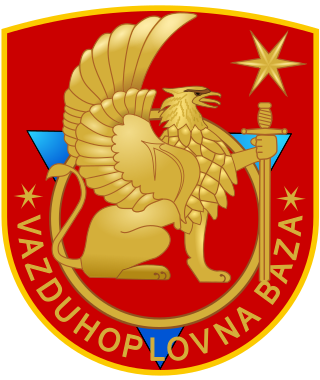
The Montenegrin Air Force is the air arm of the Military of Montenegro. The aircraft marking of the Montenegrin Air Force consist of a red-on-gold roundel, currently being the sole air arm using the latter colour in its official insignia.

Split was a Koni-class frigate in service with the Yugoslav Navy (JRM). Laid down and completed during the late 1970s as Sokol of the Soviet Navy, it was the fourth ship of a class that was being built by the Zelenodolsk Shipyard primarily for export to various friendly navies. The ship was acquired by the JRM in 1980 and commissioned as Split, becoming the second ship in JRM service to be named after the city of Split. It was soon followed by a second Koni-class hull, Koper (VPBR-32), commissioned in the JRM in 1982. Designated as a Large Patrol Boat by the JRM, Split's original armament consisting of naval guns, anti-submarine rocket launchers and anti-aircraft missiles was further improved by the addition of four P-20 anti-ship missiles, making it the most versatile ship in the JRM inventory at the time.

The Končar class is a class of six missile boats built for the Yugoslav Navy during the late 1970s at Tito's Shipyard Kraljevica, SR Croatia. The boats featured a mixture of Western and Eastern European equipment, including Soviet anti-ship missiles and Swedish guns.
The Battle of the Dalmatian Channels was a three-day confrontation between three tactical groups of Yugoslav Navy ships and coastal artillery, and a detachment of naval commandos of the Croatian Navy fought on 14–16 November 1991 during the Croatian War of Independence. On 14 November, the commandos torpedoed the Mirna-class patrol boat PČ-176 Mukos close to the island of Brač in the Split Channel of the Adriatic Sea, prompting a Yugoslav naval bombardment of Brač and Šolta Island the same day. The drifting Mukos was salvaged by Croatian civilian boats and beached at Nečujam bay.
Ugor (PO-92) was a PO-class logistic transport ship of the Yugoslav Navy, built in 1983 and classed as an ammunition auxiliary. Later sold into merchant service, the ship traded under Montenegrin ownership with the names Kairos I and Boka Star. She was seized in 2002 by the Croatian authorities for arms smuggling and later demolished as Star.
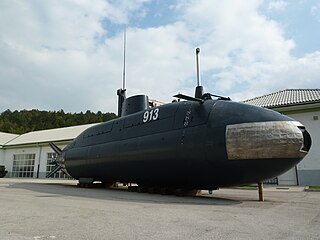
The Una-class submarine was a class of six midget submarines built for the Yugoslav Navy at the Brodogradilište specijalnih objekata during the 1980s. They were designed with the purpose of laying small minefields and transporting naval special forces, with or without their submersibles, in shallow waters that were inaccessible for larger submarines. Due to their mission profile that called for a small design as well as the need to stay undetected, they lacked torpedo armament and a generator for battery recharging.
The 1947–48 Montenegrin Republic League was the third season of Montenegrin Republic League. The season began in October 1947 and ended in May 1948.
